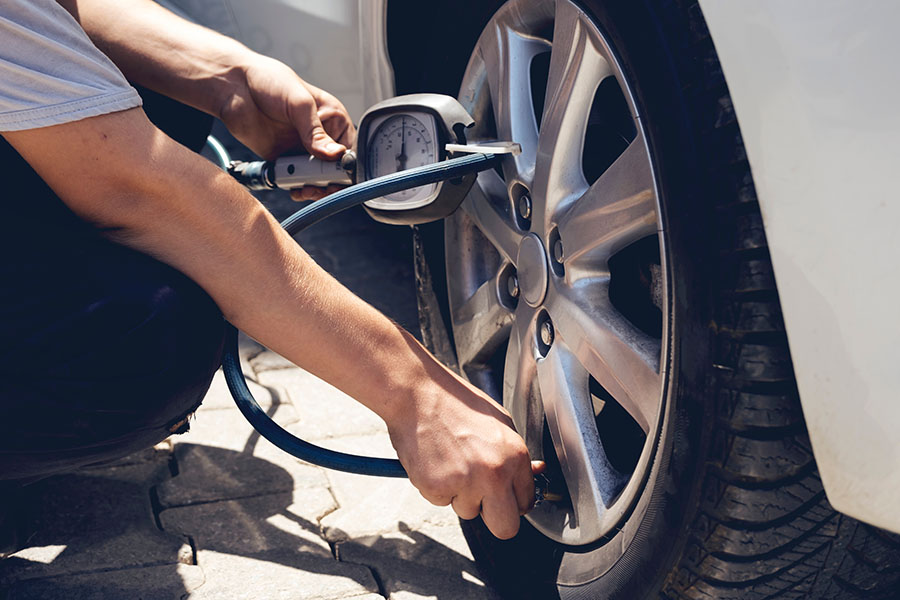VW Passat is equipped with Tire Pressure Monitoring System (TPMS) for the purpose of warning the driver when one or more of the tires are significantly under-inflated, creating a potentially unsafe driving condition. In this article we discuss the reasons for the amber colored TPMS warning light in Passat, and how you can reset it.

The TPMS warning light illuminates in VW Passat when air pressure is low in one or more of the tires, or there is a malfunction in an ABS speed sensor.
Low tire pressure
When the amber colored TPMS warning light  turns on in your Passat, stop your vehicle when it is safe to do so and check tire pressure on all the wheels, including the spare wheel (if your vehicle has one). Driving on a significantly under-inflated tire causes the tire to overheat and can lead to tire failure.
turns on in your Passat, stop your vehicle when it is safe to do so and check tire pressure on all the wheels, including the spare wheel (if your vehicle has one). Driving on a significantly under-inflated tire causes the tire to overheat and can lead to tire failure.

Reinflate the tires
Reinflate all the tires of your Passat to the manufacturer specified air pressure, which is mentioned on the vehicle placard or tire inflation pressure label usually located on the B-pillar or the edge of the driver door.

If you can’t find the label, check the size of your tire which is mentioned on the sidewall of the tire, and match it to the tire pressure information shown below. These are official cold tire pressure values for B8 Passat from Volkswagen.
- 215/60 R16: 35 psi
- 215/55 R17: 35 psi
- 235/45 R18: 35 psi
- 235/40 R19: 35 psi
- 135/90 R16: 60 psi

Resetting the TPMS warning light
After you have inflated all the tires to the correct air pressure, you must reinitialize the TPMS system. The tire pressure monitoring system in VW Passat senses change in radius of the tire with the help of ABS speed sensors. If the tire pressure decreases below the recommended pressure, the system warning light will be illuminated.
Calibrating the Tire Pressure Monitoring System
The Tire Pressure Monitoring System must be recalibrated under the following conditions:
- If the tire pressures were adjusted.
- If one or more wheels were changed.
- If one or more wheels were repaired.
- If the wheels were rotated, for example from front to rear.
The Tire Pressure Monitoring System must only be recalibrated if all tires are inflated to the correct pressure when they are cold. In order to measure the tire pressure on cold tires, the vehicle must be left to stand for 3 hours or only be driven slowly over short distances during this time.
Important: After being warned about a low tire pressure, switch the ignition off and back on. The Tire Pressure Monitoring System can only be recalibrated after this is done.
- Switch the ignition on.
- Open the glove box and locate the TPMS reset button labelled “SET”.
- Press and hold the SET button until a confirmation tone sounds.
Or: Depending on the vehicle equipment, open the Tire pressure menu item on the instrument cluster display and save the new tire pressures. - After longer trips and different vehicle speeds, the system adapts to the new values and monitors them.

Chilly weather can turn on low tire pressure light in Passat
Cold weather is one of the most common cause for low tire pressure warning light in VW Passat. When analyzing WheelsJoint’s statistical data, it has been observed that there is sharp rise in the number of searches for TPMS warning light causes at the start of every winter season, about three times higher as compared to mid summer season.

The air, like most other substances, expands when heated and contracts when cooled. So when the weather gets colder, the tire pressure decreases, which could trigger TPMS warning light in Passat. The tire pressure will vary with temperature by about 1 psi (7 kPa) for every 12°F (6.5°C).

Inflate tires when cold
Tire pressure in Passat should always be set based on cold inflation tire pressure. This is defined as the tire pressure after the vehicle has not been driven for at least three hours, or driven less than 1 mile (1.6 km) after a three-hour period.
Do not adjust tire pressure when hot
The tires on your Passat can get around 50 degrees hotter than the outside temperature when you’re driving, which increases the tire pressure by about 4 psi – this is normal and there should be no adjustment for this increased pressure.
Does altitude affect tire pressure?
Yes, altitude can change tire pressure values, but it is negligible and not a cause for concern. If you drive your Passat from sea level to Mount Evans Scenic Byway in Colorado which is the highest paved road in North America at the altitude of 14,130 feet (4,307 m), the tire pressure should theoretically increase by approximately 6 psi. But, the decrease in ambient temperature at higher elevation contracts the air in tires and compensates for any altitude pressure changes.
Is it safe to drive Passat with low tire pressure?
The driving characteristics of Passat change even if the air pressure is 5 psi less than manufacturer’s recommended value: the braking distance can be longer, cornering worse, and at particularly high speeds there is even a risk that the tire will burst. Low tire pressure also increases tire wear, and the higher rolling resistance of the tire means higher fuel consumption. So it is recommended to reinflate the tires to the correct pressure as soon as possible.
VW Passat TPMS user guide
Tire Pressure Monitoring System monitors various parameters, including rolling circumference, of all four tires using ABS sensors (indirect measurements) while the vehicle is in motion.
The reference pressure for the Tire Pressure Monitoring System is the recommended tire pressure for the tires installed at the factory when the tires are cold at maximum load. The reference pressure corresponds to the details on the tire pressure label.
If the tire pressure has been correctly adjusted on all four tires, the Tire Pressure Monitoring System must be re-calibrated. This adapts the reference pressure to the current tire pressure.
The Tire Pressure Monitoring System  may not react at first or may not react at all when you are driving in a sporty manner, or on snow-covered or unpaved roads, when you are driving with snow chains, or in certain other situations. A change in the tread circumference of a tire is signaled by the Tire Pressure Monitoring System indicator in the instrument cluster (telltale).
may not react at first or may not react at all when you are driving in a sporty manner, or on snow-covered or unpaved roads, when you are driving with snow chains, or in certain other situations. A change in the tread circumference of a tire is signaled by the Tire Pressure Monitoring System indicator in the instrument cluster (telltale).
The tire pressure recommended for the tires originally installed on the vehicle is on a sticker on the driver door jamb.
Each tire, including the spare (if provided), should be checked monthly when cold and inflated to the inflation pressure recommended by the vehicle manufacturer on the vehicle placard or tire inflation pressure label. (If your vehicle has tires of a different size than the size indicated on the vehicle placard or tire inflation pressure label, you should determine the proper tire inflation pressure for those tires).
As an added safety feature, your vehicle has been equipped with a tire pressure monitoring system (TPMS) that illuminates a low tire pressure telltale when one or more of your tires is significantly under-inflated. Accordingly, when the low tire pressure telltale illuminates, you should stop and check your tires as soon as possible, and inflate them to the proper pressure. Driving on a significantly under-inflated tire causes the tire to overheat and can lead to tire failure. Under-inflation also reduces fuel efficiency and tire tread life, and may affect the vehicle’s handling and stopping ability.
Please note that the TPMS is not a substitute for proper tire maintenance, and it is the driver’s responsibility to maintain correct tire pressure, even if under-inflation has not reached the level to trigger illumination of the TPMS low tire pressure telltale.
Your vehicle has also been equipped with a TPMS malfunction indicator to indicate when the system is not operating properly. The TPMS malfunction indicator is combined with the low tire pressure telltale. When the system detects a malfunction, the telltale will flash for approximately one minute and then remain continuously illuminated. This sequence will continue upon subsequent vehicle start-ups as long as the malfunction exists.
When the malfunction indicator is illuminated, the system may not be able to detect or signal low tire pressure as intended. TPMS malfunctions may occur for a variety of reasons, including the installation of replacement or alternate tires or wheels on the vehicle that prevent the TPMS from functioning properly. Always check the TPMS malfunction telltale after replacing one or more tires or wheels on your vehicle to ensure that the replacement or alternate tires and wheels allow the TPMS to continue to function properly.
Note: New tires may expand slightly the first time they are driven at high speeds, which can trigger a tire pressure warning.
Note: Only replace old tires with tires that have been approved by Volkswagen for the vehicle model.
Note: The Tire Pressure Monitoring System will not work if the ESC or ABS is malfunctioning
Function description
Using the ABS sensors, the Tire Pressure Monitoring System compares the RPM and thus the rolling circumference of the individual tires.
The rolling circumference can change if:
- The tire pressure has changed.
- The tire pressure is too low.
- The tire has structural damage.
- One side of the vehicle has a heavier load than the other.
- Snow chains are installed on the tires.
- A compact spare wheel has been installed.
- Only one wheel was replaced on each axle.
The Tire Pressure Monitoring System may be delayed or not be displayed at all when driving with a sporty style, on winter or unpaved roads, or when driving with snow chains.
The Tire Pressure Monitoring System shows a change in the rolling circumference of the tires via the warning light in the instrument cluster.
The recommended tire pressure for the tires installed at the factory is specified on the tire pressure sticker on the driver door pillar.
The tire pressure of all tires, including the spare wheel or temporary spare wheel, must be checked once a month when the tires are cold and must correspond to the vehicle manufacturer’s specifications on the tire pressure sticker. If the size of the tires installed at the factory differs from the details on the identification label or on the tire pressure label, the correct tire pressure must be determined.
The Tire Pressure Monitoring System is not intended to replace regular inspection and maintenance of the tires. The driver is responsible for ensuring that the correct tire pressure is used at all times, even if the Tire Pressure Monitoring System is not showing a warning that the tire pressure is too low.
The Tire Pressure Monitoring System also has a malfunction display that is accompanied by the warning light. In the event of a malfunction in the Tire Pressure Monitoring System, after switching on the ignition, the warning light blinks for around one minute and then stays on.
If the Tire Pressure Monitoring System displays a malfunction, the tire pressure cannot be monitored correctly. A malfunction in the Tire Pressure Monitoring System can have a number of causes, e.g. a wheel or a tire being replaced. After replacing a wheel or tire, you must check whether the warning light displays a system malfunction to make sure that the Tire Pressure Monitoring System is working properly.
Warnings!
- The intelligent technology of the Tire Pressure Monitoring System (TPMS) cannot overcome the natural laws of physics and it can only operate within the limits of the system. Handling wheels and tires incorrectly can result in a sudden loss of tire pressure, tread separation, and ruptured tires.
- Check the tire pressure regularly and always maintain the specified values ⇒ Tire pressure. If the tire pressure is too low, the tire can heat up so much that the tread separates or the tire ruptures.
- Always inflate the tires to the correct tire pressure when the tires are cold according to the tire inflation pressure label.
- Check the tire pressure regularly when the tires are cold. If necessary, adjust the tire pressure when the tires are cold so that it is suitable for the tires installed on your vehicle.
- Check the tires regularly for signs of wear or damage.
- Never exceed the maximum permissible speed and tire load specified for the tires fitted to your vehicle.
- If the warning light turns on, stop the vehicle immediately and check all of the tires.
- Different tire pressures or low tire pressure can increase tire wear, decrease vehicle stability, and increase braking distance.
- The driver is responsible for maintaining the correct tire pressure in all tires on the vehicle. The recommended tire pressure can be found on a label.
- The Tire Pressure Monitoring System (TPMS) can only function correctly when all tires are inflated to the correct pressure when they are cold.
- All tires must always be inflated to the correct pressure based on the load.
- Inflate all tires to the correct tire pressure before every drive.
- When the tire pressure is too low, the tire must flex more when driving. This could cause the tire to become so hot that the tread could separate, the tire could rupture, and you could lose control of the vehicle.
- Driving at high speeds and excessive vehicle load can cause a tire to become so hot that the tire could rupture and you could lose control of the vehicle.
- Tire pressure that is too high or too low shortens the service life of the tire and affects driving behavior.
- If the tire is not “flat” and the tire does not need to be replaced immediately, drive slowly to the nearest authorized Volkswagen dealer or authorized Volkswagen Service Facility to have the tire pressure checked and corrected. Volkswagen recommends contacting an authorized Volkswagen dealer or authorized Volkswagen Service Facility.
- The Tire Pressure Monitoring System must always be correctly calibrated.
Reset the entire system
If the low tire pressure warning light won’t turn off due to a glitch in the tire pressure monitoring system, it may be possible to reset the TPMS system by resetting all on-board computers in your Passat. This method should only be considered as a last resort, when all else fails.

You can reboot all the on-board computers by disconnecting the main 12 volt battery for a few minutes. Remove the cable from the negative terminal of the battery first, then from the positive terminal. With the battery disconnected, press the horn button a few times and turn on the headlights to drain out all the residual electricity from the system. After about 15 minutes, reconnect the battery in reverse order: positive cable first, then negative cable.
Tire pressure keeps getting low
If the TPMS warning light turns on frequently in your Passat, and the tire pressure is also decreasing after you have reinflated the tires, there may be an air leak. One or more of the tires may have been punctured by an external object, or the air may be leaking from a defective value stem.

Can I disable the TPMS system in Passat?
No, the TPMS system is federally mandated, and cannot be disabled in VW Passat. All vehicles must have a working tire pressure monitoring system to be legally compliant.
Use OBD2 scanner for diagnosis
Since VW Passat is equipped with on-board diagnostics (OBD), a fault diagnosis can provide initial indications of where the malfunction is located. But when it comes to TPMS, a basic code reader will not suffice. You will need an advanced scanner to monitor TPMS data or read TPMS codes.

BlueDriver is a commonly used scanner by DIYers that can read TPMS codes for most vehicles and isn’t too expensive – costs about a hundred bucks. You can also clear the TPMS fault codes with this device which will turn off the warning light, but the light may come back on if the on-board diagnostic system detects a fault again.



